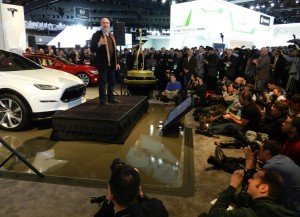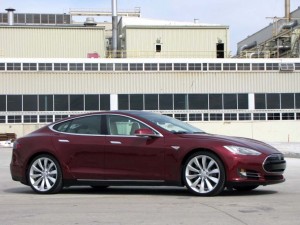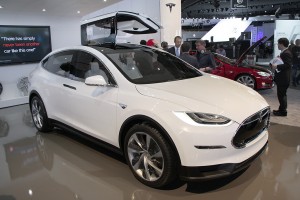
Tesla's George Blankenship told reporters at the Detroit Auto Show that the company is moving head with its sales plan.
Tesla will begin selling the mid-level 230-mile version of its Model S battery-electric sedan within a month and will roll out a lower-priced model by spring.
Tesla, which launched sales of its battery sedan last summer, has struggled to get the Model S project up to speed, raising concerns about its viability. But during an appearance at the Detroit Auto Show, a senior executive said the company now has enough money coming to fund its operation.
George Blankenship, Tesla’s vice president of Design and Store Development, told TheDetroitBureau.com at the Detroit Auto Show that the company has changed modes, going from spending a lot of money on things like robots and raw materials and moving to a phase where its revenue will fund operations.
So what challenges does the fledgling automaker face? Click below to find out.

Tesla will begin building the Model S with a smaller 60kWh battery within the next two or three weeks.
“Now what’s happening is we’re delivering cars,” Blankenship said after making his remarks at the North American International Auto Show about the difference between the time when it was preparing to sell cars and now actually selling them.
Initial sales of the Model S were only for the top-of-the-line model with the 85kWh battery. Blankenship said production of the mid-level 60kWh battery packs has begun and Tesla will start selling cars with those battery packs within the next two to three weeks. It plans to begin production of the 40kWh batteries for the entry-level Model S in March, with sales beginning as early as April.
While the 85kWh model starts at $72,400 – factoring in the $7,500 U.S. government tax credit and has a range of 300 miles, according to Tesla. The 60kWh model will start at $62,400 with a predicted range of 230 miles and the base 40kWh model will start at $52,400 with an expected range of 160 miles.
Blankenship added that the company continues to set its target at 20,000 sales for the first year of Model S sales. He said that the current production line at its Fremont, Calif., plant could produce about 50,000 of the Model S and the upcoming Model X once it goes into production.
The plant, formerly operated by Toyota and General Motors as New United Motors Manufacturing Inc. or NUMMI, covers 5 million square feet and Tesla is currently using just a small section of it, so there’s plenty of room for expansion.
Blankenship also addressed its plan to set up its new Superchargers, where Model S owners will be able to plug in and charge up for another 150 miles of driving range in just half an hour – about enough time to get out of the car and have dinner.
Click here to read more about Tesla’s Superchargers.
Access to the Superchargers – which will only work with the top-level 85kW – is free and will always be free, Blankenship said. Superchargers are powered by solar electricity. Setting up and expanding the Supercharger network is critical for Tesla’s success to remove the often-cited complaint about range anxiety for EVs.
“It’s about getting people to drive electric,” Blankenship said. “We think it’s incredibly important to do this.”
The company’s plan is to focus Supercharger installations on the corridors along the East and West coasts, but also install what he called “logicals,” such as between Montreal and Toronto.
“We’re going to introduce Superchargers everywhere in North America,” Blankenship said.

The Tesla thinks its Model X will bring efficiency to a vehicle category that is currently lacking it.
Tesla is not concerned about Nissan’s Monday announcement chopping the price of its Leaf EV by about $6,000, Blankenship said, because the cars don’t compete directly. The price cut brings the base price of the Leaf to about $18,000 (after the $7,500 tax credit), while the lowest-priced Model S will start at $52,400, with the tax credit.
“There is no competition at this show for us,” Blankenship said.
The company is moving quickly to expand distribution to international markets, including a recently opened European distribution center. Half of the 25 new stores it will open will be in international markets, including one in China, where Blankenship sees big opportunities for Tesla.
The company will add its Model X, seven-seat crossover, in 2014 and a two or three years after that, its third-generation car, which it hopes to sell for about $30,000. Like the X, the third-generation car will use the platform developed by the S.
